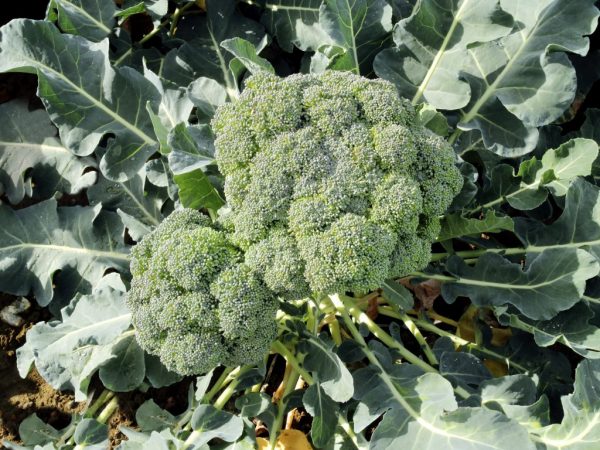Broccoli
Broccoli is an annual plant in the cabbage family. It is one of the subspecies of cauliflower - similar to its head, but with an elongated stem. The head is green, the inflorescences are side by side pressed against each other. The calorie content of broccoli depends on the type of cooking.
- Types and varieties of broccoli cabbage
- Choosing and storing broccoli
- Broccoli in cooking
- Calorie content
- Composition and useful properties
- Harm from broccoli cabbage
- Slimming broccoli
- Composition of boiled broccoli cabbage
- The benefits and harms of boiled broccoli
- Frozen broccoli composition
- Calorie content of fried broccoli
- Conclusion

Broccoli
Types and varieties of broccoli cabbage
Cabbage broccoli calabrez or, as it is also called, Calabrian, differs in color: heads of cabbage are purple, brown, white, yellow and dark green.
The second grade is asparagus or Italian. It looks like a long regular broccoli, with stems and a limp top. Italian cabbage tastes like asparagus, nutritional value, calorie content of such broccoli is the same.
Cabbage ripens well in temperate climates and is primitive.
Popular varieties:
- early maturing - Tonus, Laser, Monaco;
- mid-season - Linda, Arcadia, Vitamin;
- middle late - Romanesco, Monterey.
The difference in the calorie content of early-ripening and late-ripening varieties of broccoli is only 2 kcal.
Choosing and storing broccoli cabbage
When buying salad cabbage, they look at its appearance: the color should be dark green, without rottenness, lethargy, spots. The shelf life of fresh cabbage should not exceed 7-9 days, otherwise the beneficial substances will be lost.
Cooking should not be put on the back burner, otherwise the product will deteriorate - its nutritional value will be lost.
When buying in stores, the main thing is to buy a product in transparent packaging: this makes it easier to see the state of the cabbage.
Broccoli in cooking
Broccoli has a pungent flavor, but is good to eat even raw. Salads are prepared from cabbage, combine it with other raw vegetables, sauces. At the same time, there is no need to worry about the waist: the calorie content of broccoli is only 28 kilocalories per 100 grams of product.
A way to save more vitamins and significantly reduce the calorie content of broccoli is to steam the vegetable. This takes about 3-4 minutes. It is paired with eggs, chicken, turkey, seafood, fish and meat products.
Calorie content
Broccoli is low in calories.
In more detail, the calorie content is shown in the table:
| condition | Caloric content per 100 g |
| Fresh | 28 kcal |
| Boiled | 27 kcal |
| Frozen | 24 kcal |
Composition and useful properties

Cabbage has a positive effect on blood vessels
The calorie content of frozen broccoli is only 24 kcal per 100 grams. It contains fiber, potassium, calcium, phosphorus, magnesium, iron. All of these elements are needed by the gastrointestinal tract to function properly. Fiber, like a brush, removes the remaining food from the walls of the ventricle, and this allows poisonous substances not to linger.
The product contains a large amount of ascorbic acid. Cabbage has an effect on the cardiovascular system. Potassium, which it contains, regenerates the walls of blood vessels.
The maximum amount of sulfarophon is found in vegetable seedlings (sprouts). This element reduces the risk of oncology and limits the growth of existing tumors. By adding this vegetable to meals, athletes increase the amount of protein before training.
Harm from broccoli cabbage
Broccoli cabbage is not allowed for use by people with high stomach acidity and pancreatitis, as well as those who have an individual intolerance to the vegetable.
Slimming broccoli
Most diets and good nutrition include calculating the calorie content of broccoli when added to different meals. Fasting days are made on cabbage.
To get rid of excess weight, several days a week you should replace the side dish with such a vegetable, especially since there are many useful substances in cabbage.
Calories in broccoli are sometimes not even included in the weight loss diary because they are burned quickly.
Composition of boiled broccoli cabbage
The calorie content of boiled broccoli is 27 kcal per 100 g of product. It is rich in nutrients. It contains vitamins PP, E, B6, B2, A, C, K, B1, as well as calcium, sodium, phosphorus, magnesium, iron, manganese, potassium, chromium, iodine, copper, boron, carotene, carbohydrates, proteins ...
The benefits and harms of boiled broccoli
For the prevention of diseases, it is recommended to add 200 g of broccoli to food every day. Cabbage is a fat-burning crop. The mineral properties contained in the vegetable give the cabbage a special value. Potassium normalizes the percentage of salt, calcium and phosphorus - an integral component necessary for the brain and bones, cobalt and iron help in hematopoiesis. Broccoli destroys living cells, cleanses the intestines of cholesterol, strengthens blood vessels and restores the skin.
Despite the large amount of nutrients that are included in the composition, sometimes boiled broccoli can be harmful. The limitation to the use of broccoli in food is the increased acidity of gastric juice. Before being treated, including this vegetable in the diet, you should consult your doctor.
Frozen broccoli composition
The frozen cabbage contains a lot of fiber, vitamins C, A, B1, B6. This makes it valuable and nutritious. Its calorie content is only 24 kilocalories per 100 grams.
It is also suitable for people with heart and intestinal problems, boosts immunity and kills bacteria. Frozen broccoli strengthens the walls of blood vessels, provides the body with energy.
Calorie content of fried broccoli
The calorie content of fried cabbage increases to 46 kcal per 100 g.
Conclusion
Broccoli is popular in Europe and Russia. It is good to eat it raw, fried or boiled. Dishes with boiled vegetables are especially popular.

